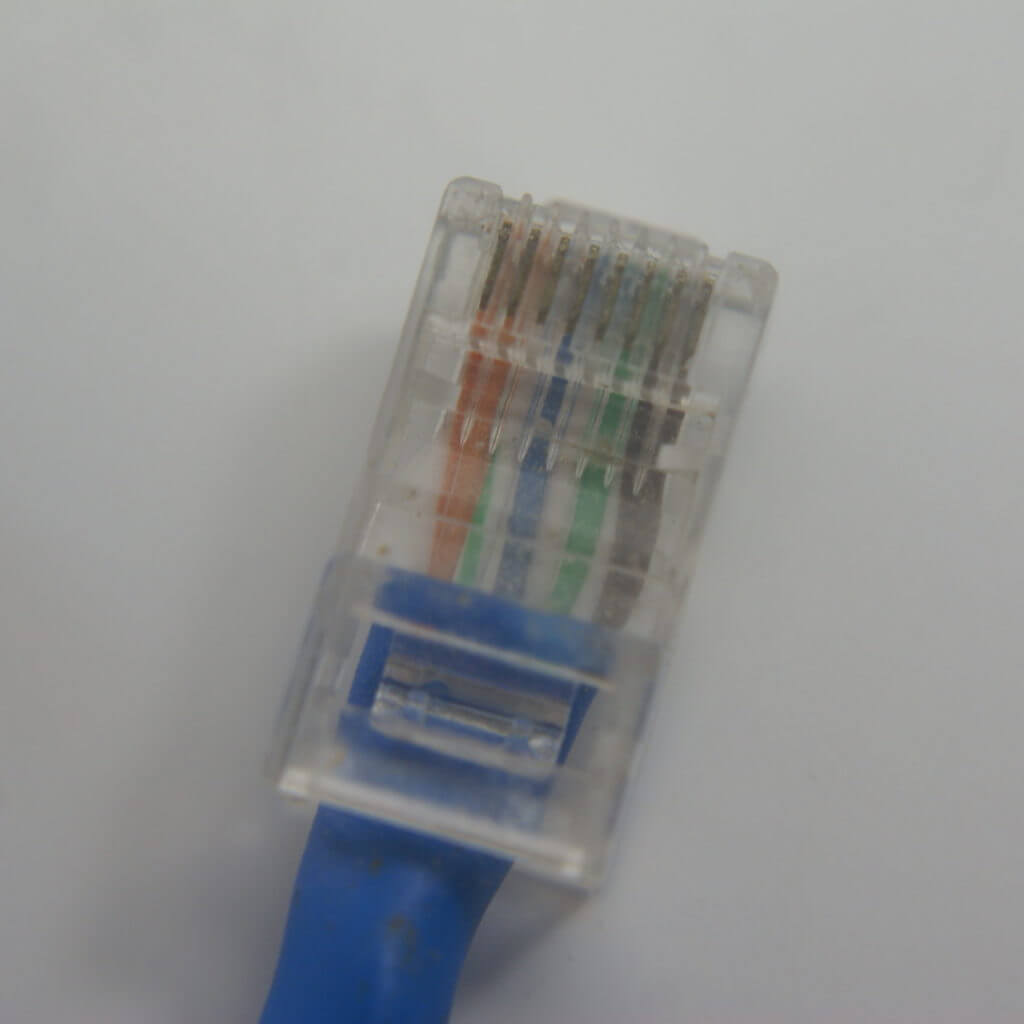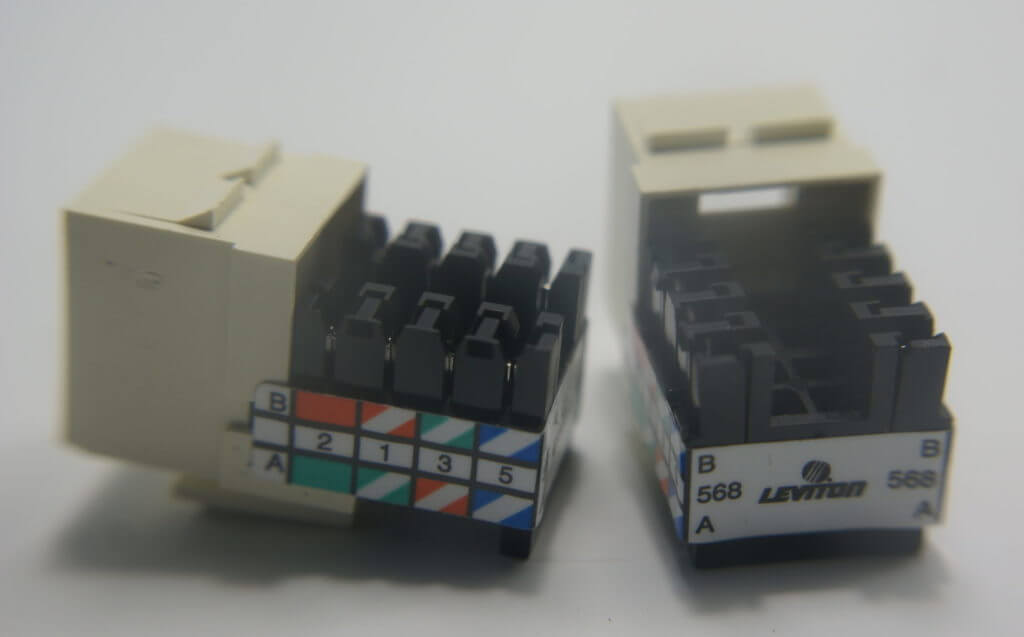One of the first questions that need to be answered at the beginning of every physical networking project is which of the two most common wiring standards will be followed on the project. When researching this topic you can find people who think all kinds of things about it. Some people think that it doesn’t matter at all which standard you choose as long as you use the same standard throughout the entire project. Other people stick to one standard or another with religious zill for some reason. I have chosen both for different situations and think that there are benefits and drawbacks to both options.
When choosing an Ethernet wiring color code the most important thing to consider is what has been used in the building in the past. A lot of problems can be caused by having multiple wiring standards in the same building so in most situations it is best to just match what is already there. If you are starting a brand new project that does not already have any cable in it I recommend that most people follow the TIA/EIA 568B standard. There are however a few situations where you may choose to follow the other standard.
After you have finished with this article you might find my guides on how to terminate Ethernet Jacks and RJ45 connectors helpful.
What is an Ethernet Wiring Standard?
An Ethernet cable is nothing more than a plastic jacket with eight individual wires inside. For the cable to work for standard applications the wires need to be connected up in the same order on both sides of the cable. Even if the wires are connected in the same order on both sides it may not work well unless several complicated factors are considered in the choosing of that order. Because of this, the Telecom Industries Association got together with the Electronic Industries Alliance to figure out the best way to connect everything up and create a standard color code for everyone to follow.
In the end, the TIA and the EIA created two distinct standards. These standards are known as TIA/EIA 568A and TIA/EIA 568B. Below you will see an example of each of these standards. When a cable is terminated using an RJ-45 jack (the male style of Ethernet connector) the pin numbers are counted from left two right with the clip facing away. By comparing any RJ-45’s that you find in your network to these pictures you can figure out what standard has been used in your property in the past.


Because registered jacks are typically not labeled you have to remember the orientation and order in witch wires are terminated. Luckily this is not the case with the female style of connector. These connectors are commonly referred to as keystone jacks and typically have a nice label that tells you everything you need to know. The labels will usually either be between the pins or along the outside of the plug. Each pin will be labeled with its pin number as well as what color of wire should be terminated there when using either of the two major standards. To see an example of this kind of connector and its label take a look at the photo at the top of this post. Another great benefit of these labels is that you can easily see what standard was used if you have keystone jacks already installed in your property.
In this table I list out the two standards by pin number. As a reminder, pin number on RJ-45 connectors counts up from one and goes from left to right. Pin number can be set up a lot of different ways with keystone jacks and you should refer to the label to see what color to use with each pin. The last thing that you need to know before you can use this table to compare terminations in any installation is that not all wires look exactly the same in Ethernet cable. In the example photos of this article the wires are all either a solid color or are white with a stripe of color. Your cable may look like this or it may have all solid colors with a lighter version of each color taking the place of the striped wires.
| Pin Number | TIA/EIA 568A Color | TIA/EIA 568B Colors |
|---|---|---|
| 1 | White/Green | White/Orange |
| 2 | Green | Orange |
| 3 | White/Orange | White/Green |
| 4 | Blue | Blue |
| 5 | White/Blue | White/Blue |
| 6 | Orange | Green |
| 7 | White/Brown | White/Brown |
| 8 | Brown | Brown |
Who Should Use the TIA/EIA 568A Standard?
The TIA/EIA 568A standard was written with backward compatibility as its number one priority. It is not as common today but back when these standards were first written most people who were installing Ethernet wanted to have the ability to use that cable as a phone line if needed. There are certain configurations of analog phone systems that will only line up if you use this standard. There is some confusion out there as to whether or not this standard is required to be able to use the cable as a phone line and the answer is no. Even a two line analog phone will work over any Ethernet cable as long as the pinout is configured in the same order on both sides. If however, you want the colors of the individual wires to line up and make sense then you need to use this standard on any network that may be used with analog phone equipment.
The second reason that this standard is used residentially is that it is so common in certain industries. The United States federal government requires that all networks that are installed with federal tax dollars use the 568A standard. Because of this many tangential industries such as higher education and the medical industry tend to use this standard as well. Such a large percentage of network engineers use the 568A standard at work that it is no surprise that they tend to prefer the same standard when they are involved with residential projects in their free time.
Who Should Use the TIA/EIA 568B Standard?
This standard is my basic recommendation for most people who are putting together a brand new residential project. I find that it is relatively uncommon to find people who are concerned with analog phone equipment anymore. And many people who are going to use the occasional phone in their network are okay with the color code not lining up perfectly if it means they get the benefits of using the TIA/EIA 568B standard. While the 568A standard focused on backward compatibility and matching color codes the 568B standard was more concerned with getting as much performance out of the cable as possible.
While both standards can produce an Ethernet cable that will perform up to its advertised speeds and distances the TIA/EIA 568B standard does have some distinct advantages. Cables terminated using this standard tend to perform better in electromagnetically noisy environments. They also tend to work better in situations that are not exactly recommended. For example, very long cables and cables that have terminations not just at the ends but also acting as splices in the middle will perform best if you are using the 568B standard.
The final reason that people commonly cite as a reason to choose the TIA/EIA 568B standard is that of future-proofing. The 568A standard is becoming less and less common outside of government work every single year. Additionally, there will no doubt come a time in the not so distant future that common household electronics will move past the Gigabit Ethernet standard and more people will find themselves in a position where they will be able to push their cabling to its very limits. In this situation, the 568B standard is a clear choice.
Straight Through, Cross Over, and Roll Over Cables
Up until now, I have only talked about cables that have the same color code pinout on both sides. These types of cables are called straight-through cables and are by far the most common type of cable out there. Most people will not need to create any other kind of cable in a residential network but I think that it is important to quickly go over what they are in case you happen to run into one in your project. I just do not want anyone to see a non-standard cable and get confused or try to copy how it is set up with new cables.
Unlike a straight-through cable, which has the same wire standard terminated on both ends, a cross-over cable will have one end terminated to the 568A standard and the other end will be terminated to the 568B standard. Cross-over cables were used in the past for a specific type of connection. If you are using only consumer-grade electronics that are less than ten or so years old in your network you will probably never need to use a cross-over cable for anything. If however, you are using very old equipment or something in your network is commercial grade there may be some situations where they are required. One such situation is when you need to network two older computers directly together without using a switch or router between them.
A roll-over cable is even less common than a cross-over cable and is only used for the console (or management) port on some commercial equipment. The way you will know that you have a roll-over cable on your hands is if one end is terminated to a regular standard and the opposite end is terminated to the exact reverse of that standard. This means that pin one will be connected to pin eight on the opposite side, pin two will be connected to pin seven, and so on.
If you see a cable that is set up in any way other than these three configurations there is a good chance that it is just terminated incorrectly. Even if the cable seems to be working it is probably set up wrong and running sub-optimally.
Conclusion
If you are looking to add a new cable into a pre-existing network the most important thing to consider is what standard has been used in the past in your building. Very few things can lead to confusion and other problems like not being one hundred percent sure what wiring standard is on the other end of the cable you are working on. You can save a lot of time and frustration just by matching the standard that is already in the building. For people who are starting their network from scratch, it is almost always better to use the TIA/EIA 568B standard. Some exceptions are for people who will be using analog phones in the network and would like all of the colors to line up correctly and for people who would like to match the United States national standard. The last thing to remember is that there are some other types of terminations and standards but as someone who is working in a residential network you should seldom see them and almost never need to use them.
Now that you have finished with this article I hope that you will find my guides on how to terminate Ethernet Jacks and RJ45 connectors helpful.
